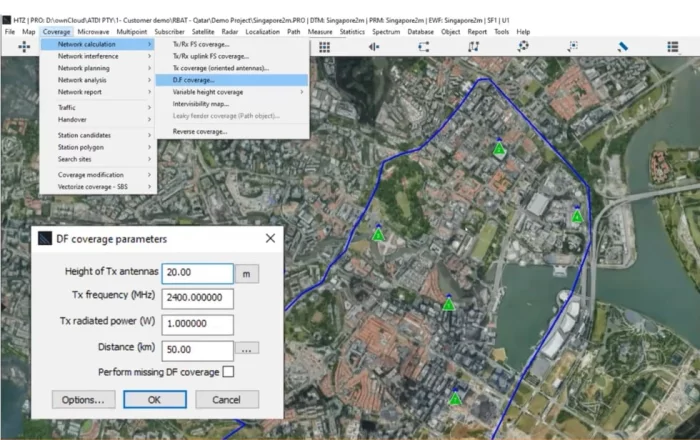HTZ Warfare: Managing drones and counter-drones to achieve air dominance
Comprehensive Counter UAV/Drone planning with HTZ Warfare
CPRA Jamming function :
GPS jamming and anti-jamming capabilities for UAV operations
Drone flight paths analysis :
Flight path signal analysis and coverage optimization tools
Counter-drone efficiency analysis :
Analyzes coverage for detecting/blocking unauthorized UAVs
Jamming threshold :
Defines signal level to classify as jamming
Jammer uplink coverage :
Maps jammer reception from virtual transmitters
Localisation :
Direction-finding accuracy mapping for non-aligned DFs
On-the-move-capabilities :
Network analysis for mobile units and convoy planning
Drone-to-drone communications :
UAV relay communications via high-altitude platforms
Details
More Products & Services
Products & Services
HTZ Warfare
ATDI South Pacific Pty Ltd
The only RF simulation software, focused exclusively on military and defence communication networks. For Army, Air Force and Navy.
Covering all military communications from VHF/UHF, HF, ground to ground, ground to air comms, every wireless technology from kHz to THz.
Complete electronic warfare simulations through radar coverage, direction finder optimization, jamming coverage and efficiency, on the move jamming, CRPA drone jamming, counter drone/UAV network planning, flight path analysis, MANET networks, etc.
With HTZ Warfare, you can simulate any electronic warfare environment for tactical mission planning, offensive or defensive electromagnetic spectrum operations.
Boasting a massive library of almost 50 radio propagation models and global cartographic data for immediate, out-of-the-box RF simulations.
Powerful, comprehensive, and complete!
Covering all military communications from VHF/UHF, HF, ground to ground, ground to air comms, every wireless technology from kHz to THz.
Complete electronic warfare simulations through radar coverage, direction finder optimization, jamming coverage and efficiency, on the move jamming, CRPA drone jamming, counter drone/UAV network planning, flight path analysis, MANET networks, etc.
With HTZ Warfare, you can simulate any electronic warfare environment for tactical mission planning, offensive or defensive electromagnetic spectrum operations.
Boasting a massive library of almost 50 radio propagation models and global cartographic data for immediate, out-of-the-box RF simulations.
Powerful, comprehensive, and complete!
HTZ Web API
ATDI South Pacific Pty Ltd
Web APIs play a pivotal role in integrating diverse systems allowing different applications to collaborate seamlessly across the web. By automating complex tasks the complexity of network deployments is removed. HTZ Web API embraces RESTful API principles and leverages standard HTTP methods, recognised for their simplicity and scalability. It supports JSON and XML formats to structure data, ensuring the API responses are lightweight and easily readable.
HTZ integrates seamlessly into third-party solutions, working as a backend spectrum engine. By adding a customised user interface, the end user can request and receive data via the API and support task automation. Requests are combined to fulfil end-user requirements or specific use scenarios.
The Web API functionality enables real-time network insights by sharing dynamic and up-to-the-minute data for informed decision-making. The API transmits real-time information like power consumption and station status through the network monitoring system. This data is then used to visualise its impact on coverage, overlay reference signals, and assess the received radio signal strength (RSSI) in specific regions. Additional information encompasses optimal server information, overlap areas, and the number of received channels. The collaborative sharing of this data ensures the adaptive reallocation of the network, acting as a security measure to protect sensitive systems and information in secure locations.
Benefits
Enhanced Accuracy: the API shared cartographic engine minimises errors, ensuring precise calculations for terrain and positioning data.
Advanced Modelling: supports complex 3D terrain and propagation analysis, delivering reliable results across various applications.
Customisable: Offers extensive custom functions to tailor solutions for specific project needs and to integrate diverse data sources.
High Performance: efficiently handles large-scale calculations, making it ideal for demanding projects.
Secure: provides robust data security and privacy in a secure environment, essential for sensitive information.
Versatile: supports every radiocommunication applications from terrestrial to satellite communications.
HTZ integrates seamlessly into third-party solutions, working as a backend spectrum engine. By adding a customised user interface, the end user can request and receive data via the API and support task automation. Requests are combined to fulfil end-user requirements or specific use scenarios.
The Web API functionality enables real-time network insights by sharing dynamic and up-to-the-minute data for informed decision-making. The API transmits real-time information like power consumption and station status through the network monitoring system. This data is then used to visualise its impact on coverage, overlay reference signals, and assess the received radio signal strength (RSSI) in specific regions. Additional information encompasses optimal server information, overlap areas, and the number of received channels. The collaborative sharing of this data ensures the adaptive reallocation of the network, acting as a security measure to protect sensitive systems and information in secure locations.
Benefits
Enhanced Accuracy: the API shared cartographic engine minimises errors, ensuring precise calculations for terrain and positioning data.
Advanced Modelling: supports complex 3D terrain and propagation analysis, delivering reliable results across various applications.
Customisable: Offers extensive custom functions to tailor solutions for specific project needs and to integrate diverse data sources.
High Performance: efficiently handles large-scale calculations, making it ideal for demanding projects.
Secure: provides robust data security and privacy in a secure environment, essential for sensitive information.
Versatile: supports every radiocommunication applications from terrestrial to satellite communications.
ICS Monitoring SDRN Control
ATDI South Pacific Pty Ltd
ICS Monitoring is a flexible network monitoring solution that allows users to better understand the impact of interference on their network and others. It is compatible with leading hardware monitoring equipment suppliers and allows the user to work with different hardware suppliers simultaneously. ICS Monitoring manages a variety of measurement data and features an automatic post-processing function for real-time data streams. It forms part of our spectrum management solution and is fully compatible with ICS Manager.
ICS Monitoring can be used to assess spectrum use, monitor emissions and regulate the control of license emissions. It performs tasks in accordance with radio license regulations and verifies compliance with the frequency allocation conditions, frequency use and channel occupancy. ICS Monitoring can be used to generate interference case studies and search for unauthorised emissions.
ICS Monitoring can be used to assess spectrum use, monitor emissions and regulate the control of license emissions. It performs tasks in accordance with radio license regulations and verifies compliance with the frequency allocation conditions, frequency use and channel occupancy. ICS Monitoring can be used to generate interference case studies and search for unauthorised emissions.
Description
Recent conflicts provide evidence that battlespace dynamics are evolving. For example, in the Ukraine/Russia war, there has been a notable shift towards achieving airspace superiority. This is evident in the increased use of unmanned aerial vehicles (UAVs) and counter-drones. Drones are proving crucial to mission success, excelling in aerial reconnaissance, precision airstrikes, and enhancing operational flexibility and efficiency. By improving situational awareness, operational effectiveness, and force protection, the military can gain a significant advantage.
HTZ oversees all aspects of interception and jamming, encompassing the planning of offensive actions, support for asset optimisation, and communications planning. Conversely, it models and analyses the impact of jamming on its networks and assets.
Catch up on some of the latest new and improved features in HTZ Warfare for managing electronic warfare in the electromagnetic spectrum.
CPRA Jamming function: Enabling GNSS receiver on UAVs to be jammed. This function also supports anti-jamming capabilities on the UAV. It allows users to plan jamming deployments to counter enemy tactics, as well ensuring uninterrupted GPS reception by estimating the enemy’s GPS jamming capacity.
Drone flight paths analysis: HTZ manages the signal received power (RSRP), signal to interference plus noise ratio (SINR) and the reference signal received quality (RSRQ) for the proposed flight path. It models the flight paths both vertically, diagonally and horizontally and supports a subscriber database. It undertakes a connectivity analysis to identify areas with and without coverage to enable the optimisation of routes and ensure continuous connectivity with the network.
Counter-drone Efficiency analysis: This feature calculates the network coverage based on various height elevations or potential flight paths of the unauthorised UAV. These coverage calculations identify areas with poor signal coverage resulting from topography and building heights which could restrict the ability to block or jam signals.
Jamming threshold: The 'jamming threshold' parameter has been introduced which denotes any received signal surpassing a given value will be classified as jamming.
Jammer Uplink coverage: Checks what can be received by the jammer while it’s jamming a virtual transmitter located anywhere on the map.
Localisation: Addition of a new mode for DF localisation accuracy maps based on location and azimuth of the DF. The accuracy is only calculated if DFs are not aligned.
On-the-move capabilities: HTZ analyses network capabilities for moving elements such as convoys in hostile terrain and identifies locations for talk-through sites. It optimises the deployment of direction finders by identifying the best sites while undertaking DF baseline coverage assessment between assets. HTZ can be integrated with the DF system to display DF hits on the planner's screen.
Drone-to-drone communications: HTZ models drone-to-drone communications where one drone uses a high-altitude platform (HAP) to extend the communication range for the drone. HTZ applies ITU-R 528 propagation model to model network coverage.
For more information or to arrange a demo, contact us today.
HTZ oversees all aspects of interception and jamming, encompassing the planning of offensive actions, support for asset optimisation, and communications planning. Conversely, it models and analyses the impact of jamming on its networks and assets.
Catch up on some of the latest new and improved features in HTZ Warfare for managing electronic warfare in the electromagnetic spectrum.
CPRA Jamming function: Enabling GNSS receiver on UAVs to be jammed. This function also supports anti-jamming capabilities on the UAV. It allows users to plan jamming deployments to counter enemy tactics, as well ensuring uninterrupted GPS reception by estimating the enemy’s GPS jamming capacity.
Drone flight paths analysis: HTZ manages the signal received power (RSRP), signal to interference plus noise ratio (SINR) and the reference signal received quality (RSRQ) for the proposed flight path. It models the flight paths both vertically, diagonally and horizontally and supports a subscriber database. It undertakes a connectivity analysis to identify areas with and without coverage to enable the optimisation of routes and ensure continuous connectivity with the network.
Counter-drone Efficiency analysis: This feature calculates the network coverage based on various height elevations or potential flight paths of the unauthorised UAV. These coverage calculations identify areas with poor signal coverage resulting from topography and building heights which could restrict the ability to block or jam signals.
Jamming threshold: The 'jamming threshold' parameter has been introduced which denotes any received signal surpassing a given value will be classified as jamming.
Jammer Uplink coverage: Checks what can be received by the jammer while it’s jamming a virtual transmitter located anywhere on the map.
Localisation: Addition of a new mode for DF localisation accuracy maps based on location and azimuth of the DF. The accuracy is only calculated if DFs are not aligned.
On-the-move capabilities: HTZ analyses network capabilities for moving elements such as convoys in hostile terrain and identifies locations for talk-through sites. It optimises the deployment of direction finders by identifying the best sites while undertaking DF baseline coverage assessment between assets. HTZ can be integrated with the DF system to display DF hits on the planner's screen.
Drone-to-drone communications: HTZ models drone-to-drone communications where one drone uses a high-altitude platform (HAP) to extend the communication range for the drone. HTZ applies ITU-R 528 propagation model to model network coverage.
For more information or to arrange a demo, contact us today.

Share
Recent Chats
Share via email
Future: handle WhatsApp here
Future: handle LinkedIn here
Future: handle Twitter here
SUBMENU HERE
Share via Chat
Copy Link


